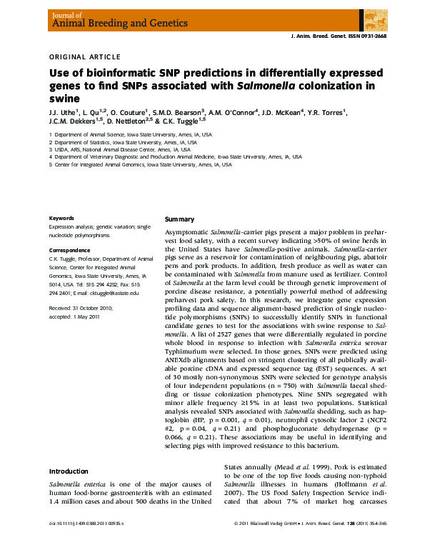
Asymptomatic Salmonella-carrier pigs present a major problem in preharvest food safety, with a recent survey indicating >50% of swine herds in the United States have Salmonella-positive animals. Salmonella-carrier pigs serve as a reservoir for contamination of neighbouring pigs, abattoir pens and pork products. In addition, fresh produce as well as water can be contaminated with Salmonella from manure used as fertilizer. Control of Salmonella at the farm level could be through genetic improvement of porcine disease resistance, a potentially powerful method of addressing preharvest pork safety. In this research, we integrate gene expression profiling data and sequence alignment-based prediction of single nucleotide polymorphisms (SNPs) to successfully identify SNPs in functional candidate genes to test for the associations with swine response to Salmonella. A list of 2527 genes that were differentially regulated in porcine whole blood in response to infection with Salmonella enterica serovar Typhimurium were selected. In those genes, SNPs were predicted using ANEXdb alignments based on stringent clustering of all publically available porcine cDNA and expressed sequence tag (EST) sequences. A set of 30 mostly non-synonymous SNPs were selected for genotype analysis of four independent populations (n = 750) with Salmonella faecal shedding or tissue colonization phenotypes. Nine SNPs segregated with minor allele frequency ≥15% in at least two populations. Statistical analysis revealed SNPs associated with Salmonella shedding, such as haptoglobin (HP, p = 0.001, q = 0.01), neutrophil cytosolic factor 2 (NCF2 #2, p = 0.04, q = 0.21) and phosphogluconate dehydrogenase (p = 0.066, q = 0.21). These associations may be useful in identifying and selecting pigs with improved resistance to this bacterium.
Available at: http://works.bepress.com/dan-nettleton/40/

This article is from Journal of Animal Breeding and Genetics 128 (2011): 354, doi:10.1111/j.1439-0388.2011.00935.x.